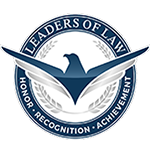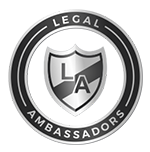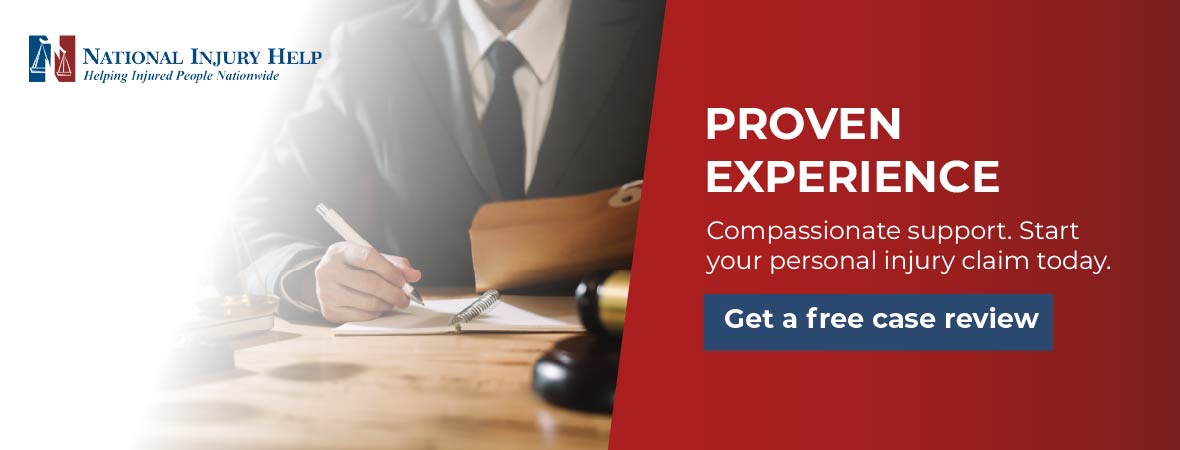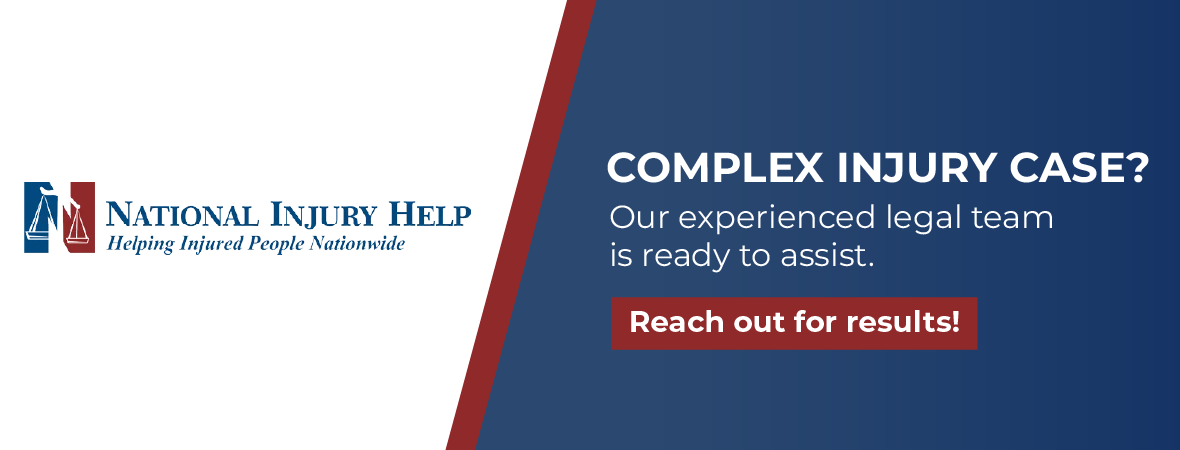Filing a personal injury claim might seem confusing, but it does not have to be. This guide walks you through every step from the moment of the injury to the final settlement. Let National Injury Help take the weight off your shoulders and fight for what you are owed. Contact us now.
When someone else’s negligence sends you to the emergency room, everything changes in an instant. One minute, you’re going about your day as usual. Next, you’re dealing with pain, medical appointments, time away from work, and mounting expenses you never saw coming. It’s overwhelming, and it’s not fair. You didn’t ask for any of this. But you’re the one left trying to sort it all out.
At National Injury Help, we know just how heavy that burden can feel. It’s not just about physical recovery; it’s also about the emotional strain of navigating an unfamiliar legal system while trying to protect your financial future. That’s where we step in. We walk beside you through every stage of your personal injury claim, making sure you understand what’s happening and what to expect. Our goal is simple: to let you focus on healing while we focus on recovering the compensation you’re legally entitled to.
In the pages that follow, we’ll break down the personal injury claims process in clear, plain language. You’ll learn what steps to take right after the injury, how to document your medical care, how fault is determined, and what it takes to get a fair settlement or verdict. While each case is unique, most follow a general timeline, from the first doctor’s visit to the final compensation check, and we’ll guide you through it, one step at a time.
Understanding this process helps you feel more in control. It prepares you to collect strong evidence, avoid common mistakes, and protect every dollar you’re owed. We’ll also highlight the state-specific differences that can affect your case, such as how blame is divided, how long you have to file a lawsuit, and whether there are any limits on the damages you can receive. These small legal details can make a big difference in how much you ultimately recover and how quickly.
Getting trusted legal help early on can shape the entire outcome of your case. You don’t have to face this alone. With the right support, every step becomes clearer, and every decision becomes easier. Let’s explore how the process works and what you can do, starting today, to move forward with confidence.
Step 1: Get Medical Help and Record the Injury
A quick doctor visit is the first building block of a winning claim.
Immediate Medical Treatment
You may feel “okay enough” after a crash or fall, yet hidden injuries, such as concussions or soft-tissue tears, often show up later. Seeing a doctor right away protects your health and your case. Each note the physician writes becomes hard proof linking the accident to your pain.
Documentation
Before you leave the scene, or as soon as you safely can, collect simple evidence:
- Take clear photos of cuts, bruises, vehicle damage, broken steps, or spilled liquids. One picture can explain more than a page of words.
- Get witness names, phone numbers, and short statements. Eyewitnesses back up what you later tell an insurance company.
- File a police or incident report and keep the report number. Officers record facts, map skid marks, and note weather, which is priceless data later on.
Step 2: Consult a Personal Injury Lawyer
Once injuries are documented, it is time to shift the legal load onto our shoulders.
Why Legal Help Matters
Most states follow some form of comparative negligence. If you are partly at fault, your award drops by that same share. A good lawyer knows how to limit blame and count every penny of lost wages, medical bills, and pain.
What Happens During the First Meeting
Your first meeting with us is free and relaxed. You explain what happened; we review early evidence and answer every question. Together, we outline possible outcomes, rough timelines, and our “no win, no fee” policy so you know costs up front.
Step 3: Investigation and Evidence Gathering
A strong claim stands on hard facts. This is where our team does the heavy lifting.
What Your Attorney Will Do
- Interview witnesses while memories are fresh.
- Secure records, ambulance sheets, hospital charts, police reports, phone photos, and security-camera footage.
- Hire experts such as accident-reconstruction engineers or orthopedic surgeons who can explain fault and medical impact in clear words.
Why This Step Matters
Each document and expert opinion ties the defendant’s carelessness to your medical bills, lost income, and future rehab costs. The clearer we prove liability and damages, the stronger your negotiating power.
Step 4: Filing the Insurance Claim
When the evidence file looks solid, we open the formal claim.
Notifying the At-Fault Party’s Insurer
We send a detailed demand letter that explains what happened, why the customer is responsible, and how much you seek. Attached documents usually include medical records, bills, photos, witness statements, and proof of lost wages.
Shared Fault and Settlement Offers
Insurers often start low, arguing you share blame. If investigators decide you are 20 percent at fault, your settlement drops by 20 percent. That is why clear evidence and sharp negotiation matter so much in every state.
Step 5: Negotiation and Settlement Talks
Most personal injury cases end here, without court papers.
Back-and-Forth Negotiations
We talk, email, and sometimes meet with insurance adjusters trained to save their company money. To push fair value, we rely on complete documentation, expert reports, and the credible threat of a lawsuit.
When a Fair Settlement Is Reached
When numbers make sense, you sign a release agreeing not to sue again, and the insurer sends payment. We then disburse funds, pay medical liens, and forward the rest to you.
When Settlement Fails
If the company stalls or offers pennies, we prepare to file a lawsuit. The choice is always yours; we explain pros, cons, and likely timelines before moving ahead.
Step 6: Filing a Personal Injury Lawsuit
Sometimes you must call the insurer’s bluff.
When and Why to File
We sue when the carrier disputes fault, downplays serious injuries, or refuses reasonable payment. A lawsuit can also help when future medical needs remain unclear and we need a judge to compel full disclosure.
Typical Lawsuit Timeline
- A complaint was filed in the proper state court.
- The defendant was served by a process server or sheriff.
- The discovery phase Both sides exchange documents, answer written questions, and sit for depositions.
- Mediation offers one more chance to settle.
- If no deal, we move toward trial.
Statute of Limitations
Most states give you two or three years from the injury date to file a lawsuit, but some allow only one year, and others as many as six.
Claims against city, state, or federal agencies require special notices, often within months. Missing these windows can erase your right to recover anything, so early legal help is vital.
Step 7: Going to Trial
Trials are public, structured, and sometimes unpredictable, yet preparation wins.
What Happens in Trial
We present medical records, expert testimony, and witness accounts so jurors see exactly how the accident hurt you. The defense cross-examines, then both sides give closing arguments. Finally, jurors deliberate and issue a verdict. Either side may appeal, but appeals are rare when the evidence is clear.
Odds of Reaching Trial
Nationwide, roughly 90 percent of personal injury claims settle before a jury hears them, yet we prepare every case as if a trial is certain. That readiness alone often pressures insurers to pay fair value.
Step 8: Receiving Your Compensation
The verdict or settlement is only a number until cash reaches your hands. First, the insurer sends the check to our firm. We deposit it in a trust account, subtract the agreed-upon attorney fee, and pay any medical liens. The remaining balance arrives by cashier’s check or wire transfer, which is your choice.
Contact a Personal Injury Lawyer Today
We created this guide with one goal in mind: to make your personal injury claims process feel less confusing and more manageable, like walking a well-marked path rather than stumbling through a maze.
We know how overwhelming things can get after an accident. One moment, life is normal, and the next, you’re juggling medical bills, insurance calls, missed work, and a hundred unanswered questions. That’s a lot for anyone to handle alone.
At National Injury Help, we’re here to walk that path with you. If you or someone you care about has been injured anywhere in the United States, whether in a car crash, a slip and fall, a workplace accident, or another incident caused by someone else’s negligence, we want you to know you’re not alone. You don’t have to figure out your next steps in the dark or settle for less than what you truly deserve.
Our team is experienced, compassionate, and ready to step in so you can breathe a little easier. While you concentrate on healing, physically and emotionally, we’ll take care of the legal side. From gathering the right evidence to dealing with the insurance companies to calculating the full extent of your damages, we make sure nothing is left behind.
We also understand that reaching out for legal help can feel intimidating, especially when money is tight. That’s why we offer free, no-obligation consultations. You can speak to a real person about what happened, ask questions, and get honest answers, without any pressure to commit.
Let’s take this next step together. Call us today at 1 (800) 214-1010, and let National Injury Help be your advocate, your legal guide, and your voice. With us on your side, you don’t just get legal support, you get a partner who is deeply committed to helping you reclaim your peace of mind and fight for the compensation you truly deserve.








